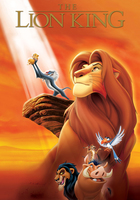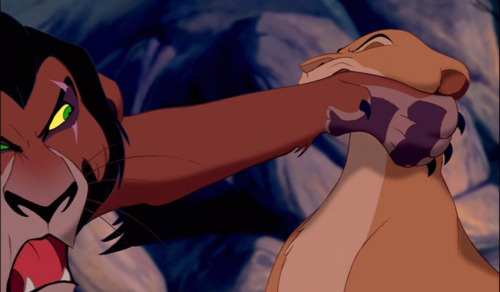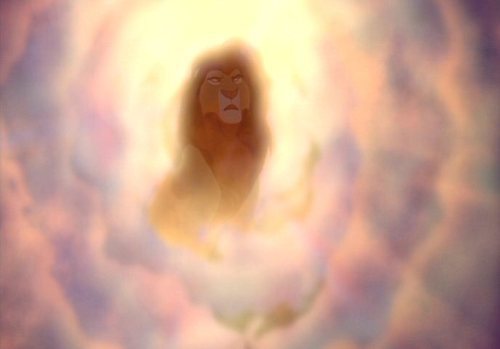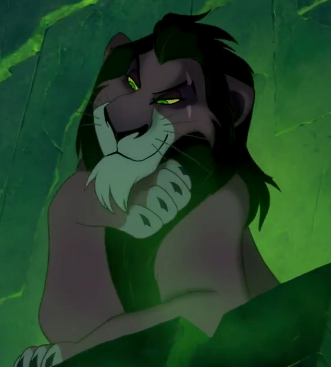
The Lion King[i] tells the story of Simba, a lion cub born into the monarchy and heir to his father Mufasa, ruler of all the animals in the Pride Lands. From learning how to pounce, to going on adventures with his best friend Nala, Simba has the perfect life, up until Mufasa is killed by Scar, his jealous brother. Simba blames himself for his father’s death and runs away, leaving Scar to take over as king. Scar allows hyenas to infiltrate the pride and abuses his position of power, treating the pride like slaves and scaring the rest of the animals into relocating. With the help of friends, old and new, and some spiritual guidance, a matured Simba returns to Pride Rock to overthrow his evil uncle and restore happiness to the Animal Kingdom.
The Lion King is an animated family musical from Disney, and is an enjoyable film for children and adults alike due to the endearingly relatable animal characters, as well as the mature themes that are prevalent throughout. Sisk states, “serious-minded adults ought not to like this sort of thing,”[ii] mainly because the talking animal aspect of the production may seem childish. However the animal characters are merely a façade, as the anthropomorphic qualities of the characters means that this is very much a human film about human characters, as “the animals have been made to act like men because the whole action has significance for men, not animals.”[iii] Sisk doesn’t believe that these types of animal films exist without human characters, because “in the bestiary everything is anthropomorphized. It has to be.”[iv] There are mature themes within the film, such as dealing with grief and issues with gender representation. The Lion King may seem like a kids film about animals that adults may enjoy, but it is so relatable and thought provoking for adults as well, that it could be argued to be an adult film that children can enjoy, particularly as it is believed to have been based on Hamlet.[v]
Gender plays a huge role in The Lion King, as females are portrayed in submissive roles whereas the majority of the main characters are male. As king, Mufasa is in charge of all the other lions and tells them what to do, whilst the only time we see the adult female lions at the beginning of the film are when they are fulfilling maternal roles, such as bathing the cubs. Stephanie Mastrostefano states that it is “symptomatic of the patriarchal discourse of the Pride Lands, the caste-royalty system sets the stage for traditional gender roles and ultimately reinforces a binary that favors primogeniture and complete female subordination,”[vi] with the females presented as passive to male dominance. This idea is reinforced by the fact that once Scar takes over as king, none of the female lions are able to stand up to him without the help of Simba, reinforcing their dependency on males. This shows women as weak and inferior to men and gives the impression that only men are able to be assertive, evident through Scar’s treatment of them as labourers as he forces them to go out hunting to bring him food, as well as when Scar physically attacks Sarabi.

The only character that attempts to break this stereotype is Nala, who is constantly playing games with Simba and manages to pin him down whenever they wrestle together. Her dominance over him is indicative of Simba’s dependency upon others; shown through his close relationship to his father, as well as the fact that he only goes back to take back the Pride Lands from Scar after Nala tracks him down. Her independence to leave the pride to find food, and then her aggressiveness in fighting Simba, shows her as the complete opposite of the impression that the film gives the rest of the female characters. Nala as an anomaly is a reference to feminism by Allers and Minkoff, and the fact that Scar’s demise is conceived through Nala’s initiative highlights that female empowerment is essential for leaving a patriarchal society in the past.
Another key theme explored throughout The Lion King is the constant battle between good and evil. Mufasa and Simba represent good, whilst Scar is symbolic of evil, with colour playing an important role in these representations. Mufasa and Simba are always brightly coloured, with the sun in the background or a strong red/orange hue engulfing them. Not only does this symbolise the warmth of their character, but also the power and respect they both evoke. These colours are reminiscent of sunshine, which is symbolic in terms of the way that they look out for the other animals, and are the focal point of the Pride Lands. They light the way and give hope to not only the other characters but also the audience, which is emphasised by Mufasa appearing in the sky as a Godlike figure to encourage Simba to return home. The imagery of the sun is consistent throughout, with Mufasa saying to Simba, “One day the sun will set on my time,” which foreshadows his eventual death and assigns leadership to Simba. The delegation of control to Simba gives hope to the audience for a positive conclusion, as they have faith in Simba to win the power battle with Scar.


In contrast, whenever Scar is alone or with his loyal team of hyenas, the atmosphere is either dark and cloudy, or lit up brightly in green. The green symbolises evil and jealousy, whilst the darkness is relevant to the unhappiness and destruction that he brings to the rest of the lions. As Scar sings about how much he wishes to be king, the lighting around him turns a fiery red, which is an imitation of Mufasa and contributes to the idea of jealousy towards his brother.
The anthropomorphic qualities of the characters is relevant to the contrast between good and evil, as Mufasa shows loyalty and respect to other animals, highlighted by him hugging Rafiki at the beginning. He encourages Simba to treat all the animals in the pride equally, with the director’s making the implication that in order to be respected one must treat others equally, and that power should not be abused. In contrast, Scar has no respect for other animals, which is shown through his taunting of a mouse and the way that he treats the hyenas as slaves. As a result, when Scar is in a position of power none of the other lions respect him, which leads to his eventual downfall, which supports the director’s intentions.
To sum up, The Lion King explores themes of female stereotypes within society, with Nala breaking tradition by displaying assertive qualities amongst a pride of submissive female lions. In contrast to the other characters who are seemingly reliant on a male leader to stand up for them and end their oppression, Nala is aggressive and independent, as she dominates Simba in wrestling games and leaves the pride in order to provide food for her family. Similarly, Simba displays defiance against the patriarchal society upon discovery of arranged marriages within the pride saying, “Well, when I’m king, that’ll be the first thing to go.” The idea of marrying two people off without their consent could be considered a backwards tradition which portrays women as disposable possessions with no say in their future. Despite still being a cub at the time, this is the first time we see some maturity and respect within Simba’s character, as he begins to develop into an adult.
Another theme concurrent throughout the film is the battle between good and evil, with both sides of the coin represented by Mufasa/Simba and Scar respectively. When Mufasa and Simba are shown on screen, there tends to be a glowing red and orange composition, which highlights their dominance with connotations to the sun. Whenever Scar is alone, the dark shadows signify darkness and despair, whilst the heavy green lighting shows the evil, jealous side to his personality. Scar’s selfish nature is highlighted throughout, particularly when it comes to his wish to become king. The difference between the two brothers is shown, as Mufasa says to Simba, “There’s more to being king than getting your way all the time.” Near the end of the film, Scar says, “I am the king, I can do whatever I want.” This naivety highlights the narrow mindedness of his ambition and is a fatal flaw, which contributes to his downfall.
In terms of other films, a good comparison for The Lion King is Brave,[vii] an animated film from Disney and Pixar. Brave was the first Pixar film that revolved around a female main character, with Merida sharing similar qualities to Nala regarding female empowerment. Merida is a princess, which ultimately means that she will be married off regardless of her wishes. Despite this, she is defiant and atypical of the traditional, submissive Disney princess. She is open for love and relationships, but doesn’t allow boys to control her life. She just wants to ride her horse and shoot her bow and is not interested in conforming to the patriarchy, much like Nala. Both characters have agency and share traits of aggressiveness and independence. Whilst Merida is the centre of a film intended for female empowerment, Nala breaks the mould despite being surrounded by submissive characters, and the eighteen-year gap between the films being released highlights the progress Disney has made in terms of feminism.
[i]Roger Allers and Rob Minkoff, The Lion King (United States: Buena Vista Pictures, 1994).
[ii]John P Sisk, ‘The Animated Cartoon’, Prairie Schooner, 27 (1953), 243–47 <http://dx.doi.org/10.2307/40624571>.
[iii]John P Sisk, ‘The Animated Cartoon’
[iv]John P Sisk, ‘The Animated Cartoon’
[v]William Shakespeare, Hamlet (New York: Dover Publications, 2000).
[vi]Stephanie Mastrostefano, Rhode Island College Digital Commons @ RIC Gender and Ideology in Disney’ S Beast Fables, 2013 <http://digitalcommons.ric.edu/cgi/viewcontent.cgi?article=1086&context=honors_projects> [accessed 18 January 2016].
[vii]Mark Andrews, Brenda Chapman and Steve Purcell, Brave(United States: Walt Disney Studios Motion Pictures, 2012).
Bibliography
1) Allers, Roger, and Rob Minkoff, The Lion King (United States: Buena Vista Pictures, 1994)
2) Andrews, Mark, Brenda Chapman, and Steve Purcell, Brave (United States: Walt Disney Studios Motion Pictures, 2012)
3) Mastrostefano, Stephanie, Rhode Island College Digital Commons @ RIC Gender and Ideology in Disney’ S Beast Fables, 2013 <http://digitalcommons.ric.edu/cgi/viewcontent.cgi?article=1086&context=honors_projects> [accessed 18 January 2016]
4) Shakespeare, William, Hamlet (New York: Dover Publications, 2000)
5) Sisk, John P, ‘The Animated Cartoon’, Prairie Schooner, 27 (1953), 243–47 http://dx.doi.org/10.2307/40624571